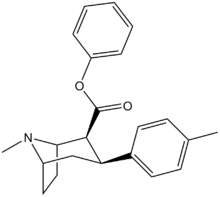Chemical compound
RTI-120
phenyl (1R,2S,3S,5S)-3-(4-methylphenyl)-8-methyl-8-azabicyclo[3.2.1]octane-2-carboxylate
CAS Number PubChem CID ChemSpider CompTox Dashboard (EPA ) Formula C 22 H 25 N O 2 Molar mass −1 3D model (JSmol )
CN1[C@@H]2C[C@H](C3=CC=C(C)C=C3)[C@H](C(OC4=CC=CC=C4)=O)[C@H]1CC2
InChI=1S/C22H25NO2/c1-15-8-10-16(11-9-15)19-14-17-12-13-20(23(17)2)21(19)22(24)25-18-6-4-3-5-7-18/h3-11,17,19-21H,12-14H2,1-2H3/t17-,19+,20+,21-/m0/s1
Key:HIQHQNWJRSNELD-KCLUMXDGSA-N
(–)-2β-Carbophenoxy-3β-(p-tolyl )tropane (RTI-4229 -120 ) is a phenyltropane derivative which acts as a reasonably selective dopamine reuptake inhibitor , along with weaker inhibition of noradrenaline and serotonin reuptake.[1] cocaine itself.[2] RTI-150 , RTI-171 and , giving it a more similar pharmacological profile to cocaine compared to longer acting analogues like RTI-121 and RTI-177 .[3]
See also [ ] List of phenyltropanes RTI-113 References [ ]
^ Silverthorn ML, Dersch CM, Baumann MH, Cadet JL, Partilla JS, Rice KC, Carroll FI, Becketts KM, Brockington A, Rothman RB (April 1995). "Studies of the biogenic amine transporters. V. Demonstration of two binding sites for the cocaine analog [125I]RTI-55 associated with the 5-HT transporter in rat brain membranes". The Journal of Pharmacology and Experimental Therapeutics . 273 (1): 213–22. PMID 7714769 . ^ Stathis M, Scheffel U, Lever SZ, Boja JW, Carroll FI, Kuhar MJ (June 1995). "Rate of binding of various inhibitors at the dopamine transporter in vivo" (PDF) . Psychopharmacology . 119 (4): 376–84. doi :10.1007/BF02245852 . PMID 7480516 . ^ Kimmel HL, Carroll FI, Kuhar MJ (December 2001). "Locomotor stimulant effects of novel phenyltropanes in the mouse". Drug and Alcohol Dependence . 65 (1): 25–36. doi :10.1016/S0376-8716(01)00144-2 . PMID 11714587 .
Phenyltropanes (classifications )
2-Carboxymethyl Esters
Troparil WIN 35428 RTI-31 RTI-32 RTI-51 RTI-55 RTI-83 (3,4-Disubstituted Phenyl)-tropanes
Dichloropane RTI-112 RTI-353 Arylcarboxy Carboxyalkyl Acyl β,α Stereochemistry α,β Stereochemistry
Brasofensine Tesofensine NS2359 Heterocycles: 3-Substituted-isoxazol-5-yl Heterocycles: 3-Substituted-1,2,4-oxadiazole N-alkyl N-replaced (S,O,C) Irreversible Nortropanes (N-demethylated)
Stimulants
Adamantanes
Adapromine Amantadine Bromantane Memantine Rimantadine Adenosine antagonists Alkylamines
Cyclopentamine Cypenamine Cyprodenate Heptaminol Isometheptene Levopropylhexedrine Methylhexaneamine Octodrine Propylhexedrine Tuaminoheptane Ampakines Arylcyclohexylamines Benzazepines
6-Br-APB SKF-77434 SKF-81297 SKF-82958 Cathinones Cholinergics Convulsants Eugeroics Oxazolines Phenethylamines Phenylmorpholines Piperazines
2C-B-BZP 3C-PEP BZP CM156 DBL-583 GBR-12783 GBR-12935 GBR-13069 GBR-13098 GBR-13119 MeOPP MBZP oMPP Vanoxerine Piperidines
1-Benzyl-4-(2-(diphenylmethoxy)ethyl)piperidine 2-Benzylpiperidine 2-Methyl-3-phenylpiperidine 3,4-Dichloromethylphenidate 4-Benzylpiperidine 4-Fluoromethylphenidate 4-Methylmethylphenidate Desoxypipradrol Difemetorex Diphenylpyraline Ethylnaphthidate Ethylphenidate Methylnaphthidate Isopropylphenidate JZ-IV-10 Methylphenidate (Dexmethylphenidate )Nocaine Phacetoperane Pipradrol Propylphenidate SCH-5472 Pyrrolidines Racetams
Oxiracetam Phenylpiracetam Phenylpiracetam hydrazide Tropanes Tryptamines Others ATC code : N06B
D1 -like
Agonists
Ergolines : Cabergoline CY-208,243 Dihydroergocryptine Lisuride Pergolide Terguride Phenethylamines : Deoxyepinephrine (N-methyldopamine, epinine) Dopexamine Etilevodopa Ibopamine L -DOPA (levodopa)Melevodopa L -PhenylalanineL -TyrosineOthers : A-68930 Apomorphine Nuciferine PF-6649751 Propylnorapomorphine Rotigotine SKF-89,145 Stepholidine Tavapadon Tetrahydropalmatine PAMs Antagonists
Typical antipsychotics : Butaclamol Chlorpromazine Chlorprothixene Flupentixol (flupenthixol) (+melitracen )Fluphenazine Loxapine Perphenazine (+amitriptyline )Thioridazine Thiothixene Trifluoperazine (+tranylcypromine )Zuclopenthixol Atypical antipsychotics : Asenapine Clorotepine Clotiapine Clozapine DHA-clozapine Fluperlapine Iloperidone Norclozapine Olanzapine (+fluoxetine )Paliperidone Quetiapine Risperidone Zicronapine Ziprasidone Zotepine Others : Ecopipam EEDQ Metitepine (methiothepin) Perlapine SCH-23390
D2 -like
Agonists
Adamantanes : Amantadine Memantine Rimantadine Aminotetralins : 5-OH-DPAT 7-OH-DPAT 8-OH-PBZI Rotigotine UH-232 Ergolines : Bromocriptine Cabergoline Chanoclavine Dihydroergocryptine Epicriptine Ergocornine Lergotrile Lisuride LSD Pergolide Terguride Phenethylamines : Deoxyepinephrine (N-methyldopamine, epinine) Dopexamine Etilevodopa Ibopamine L -DOPA (levodopa)L -PhenylalanineL -TyrosineMelevodopa Atypical antipsychotics : Alentemol (U-66444B) Aripiprazole (+sertraline )Aripiprazole lauroxil Bifeprunox Brexpiprazole Brilaroxazine Cariprazine F-15063 Lumateperone Norclozapine Others : 3-PPP A-412997 ABT-670 ABT-724 Adrafinil Aplindore Apomorphine Arketamine Armodafinil BP-897 Captodiame CP-226,269 Dizocilpine Esketamine Flibanserin Ketamine Mesulergine Modafinil OSU-6162 Pardoprunox PD-128,907 PD-168,077 PF-219,061 PF-592,379 Phencyclidine Piribedil Pramipexole Preclamol Propylnorapomorphine Pukateine Quinagolide Quinelorane Quinpirole RDS-127 Ro10-5824 Ropinirole Roxindole Salvinorin A SKF-83,959 Sumanirole Talipexole Umespirone WAY-100,635 Antagonists
Antiemetics/gastroprokinetics/sedatives : Aceprometazine AS-8112 Alimemazine Alizapride Benzquinamide Bromopride Clebopride Deudomperidone Domperidone Eticlopride Hydroxyzine Itopride Metoclopramide Metopimazine Promethazine Thiethylperazine Trimethobenzamide Antidepressants : Amoxapine Nefazodone Opipramol Propiomazine Trimipramine Others : 3-PPP Azapride Bromerguride Bromocriptine Buspirone Desmethoxyfallypride EEDQ F-15063 Fallypride Fananserin Fenfluramine Iodobenzamide L-741,626 L-745,870 Levofenfluramine Metergoline Metitepine (methiothepin) N-Methylspiperone Nafadotride Nuciferine PNU-99,194 Pridopidine Raclopride Sarizotan SB-277,011-A Sonepiprazole Spiroxatrine Stepholidine Terguride Tetrahydropalmatine Tiapride UH-232 Yohimbine
See also: Receptor/signaling modulators Adrenergics Serotonergics Monoamine reuptake inhibitors Monoamine releasing agents Monoamine metabolism modulators Monoamine neurotoxins
